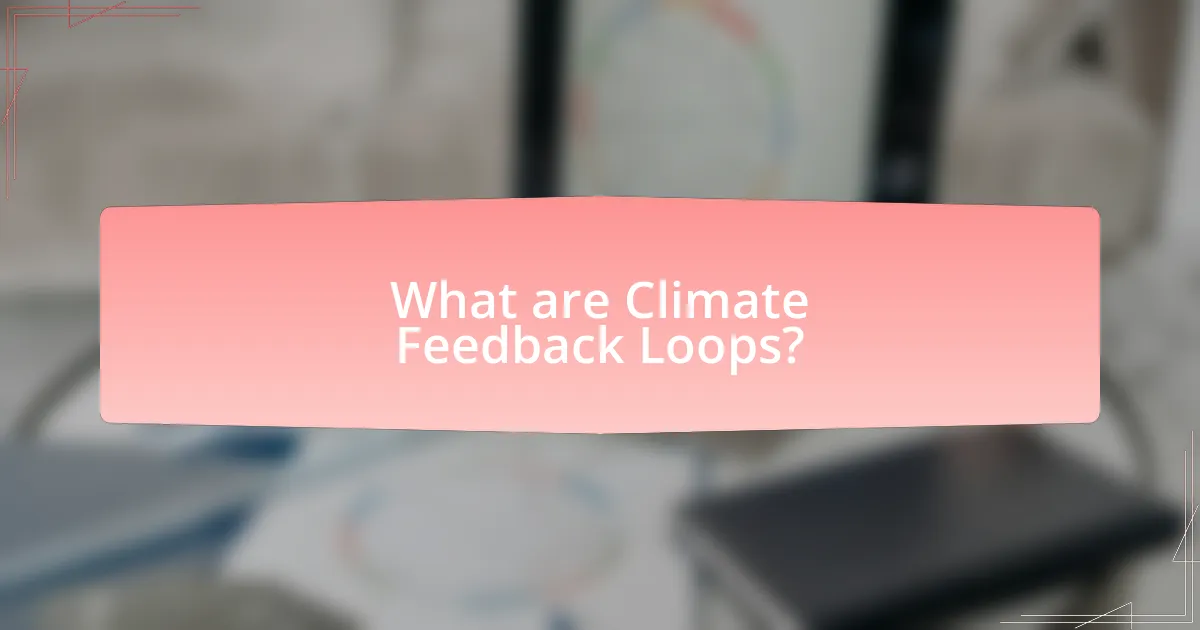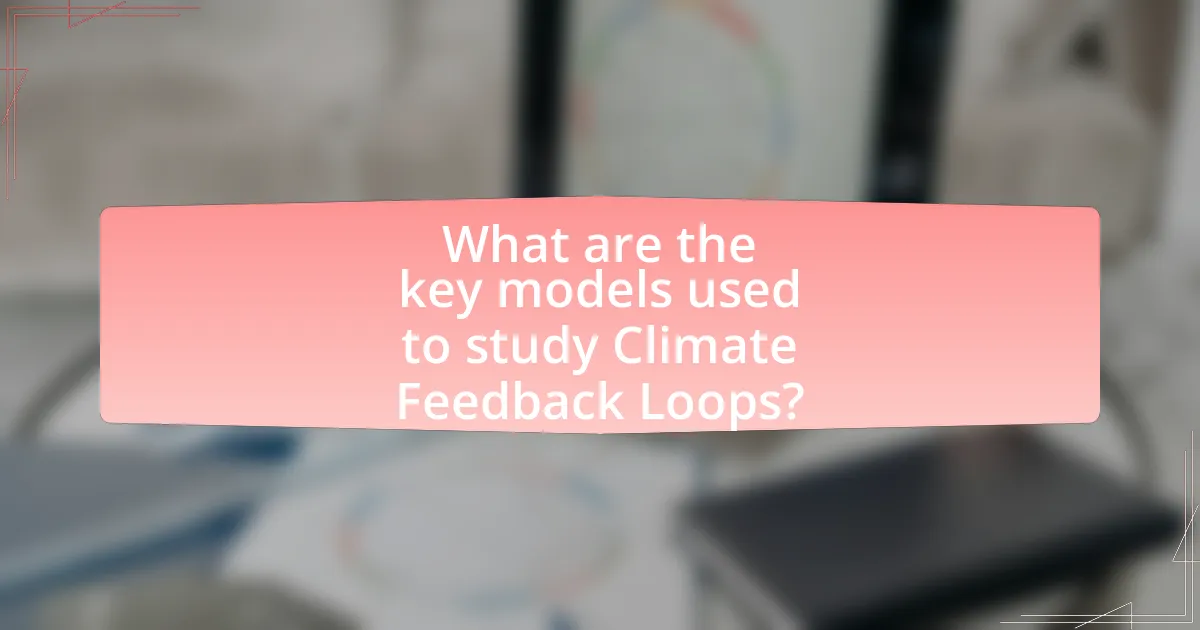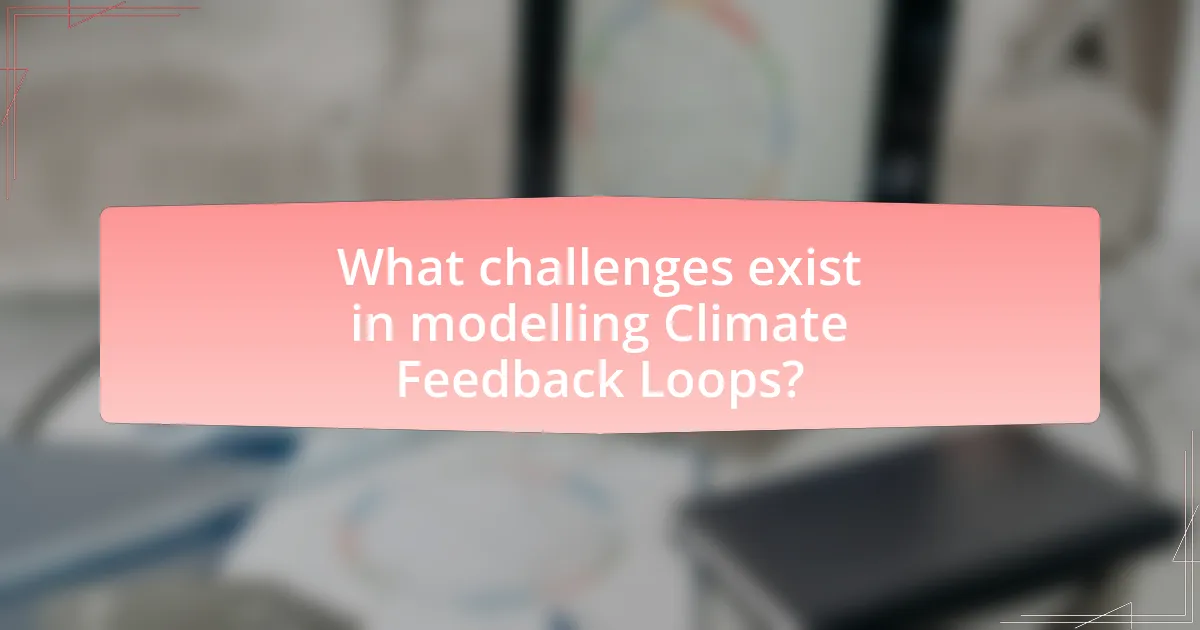Climate feedback loops are critical processes in the climate system where initial changes trigger further alterations that can either amplify or mitigate the original effects. This article explores the significance of these feedback mechanisms, detailing the primary types—positive and negative feedback loops—and their influence on climate models and predictions. It examines how feedback loops affect climate sensitivity, the methodologies used in modeling these interactions, and the challenges and uncertainties associated with accurately simulating them. Additionally, the article discusses advancements in modeling techniques and the implications of these feedback loops for climate policy and action.

What are Climate Feedback Loops?
Climate feedback loops are processes in the climate system where an initial change triggers further changes that either amplify or diminish the original effect. For example, as global temperatures rise, polar ice melts, reducing the Earth’s albedo (reflectivity) and causing more solar energy to be absorbed, which in turn leads to further warming. This interaction illustrates a positive feedback loop, where the initial warming is intensified. Conversely, increased vegetation growth due to higher CO2 levels can enhance carbon sequestration, representing a negative feedback loop that mitigates warming. These feedback mechanisms are critical in climate models, as they significantly influence predictions of future climate scenarios.
How do Climate Feedback Loops influence the climate system?
Climate feedback loops significantly influence the climate system by amplifying or dampening the effects of climate change. For instance, as global temperatures rise, ice melts, reducing the Earth’s albedo, which leads to increased absorption of solar radiation and further warming. This process is evidenced by the Arctic sea ice decline, which has decreased by approximately 40% since the late 1970s, contributing to accelerated warming in polar regions. Additionally, increased atmospheric CO2 levels enhance the greenhouse effect, leading to further temperature rises and more extreme weather patterns. These feedback mechanisms demonstrate how initial changes in the climate system can trigger responses that exacerbate or mitigate those changes, ultimately shaping the trajectory of global climate dynamics.
What are the primary types of climate feedback loops?
The primary types of climate feedback loops are positive feedback loops and negative feedback loops. Positive feedback loops amplify changes in the climate system, such as the melting of polar ice, which reduces the Earth’s albedo and leads to further warming. Negative feedback loops, on the other hand, counteract changes, such as increased cloud cover reflecting sunlight, which can help cool the Earth. These feedback mechanisms are critical in climate models, as they influence temperature projections and climate stability.
How do positive feedback loops differ from negative feedback loops?
Positive feedback loops amplify changes, leading to an increase in the initial effect, while negative feedback loops counteract changes, promoting stability by reducing the initial effect. In climate systems, a classic example of a positive feedback loop is the melting of Arctic ice; as ice melts, less sunlight is reflected, causing further warming and more ice melt. Conversely, a negative feedback loop can be observed in cloud formation; increased temperatures can lead to more cloud cover, which reflects sunlight and can cool the surface, thus stabilizing temperatures. These mechanisms illustrate how positive feedback can exacerbate climate change, while negative feedback can help mitigate it.
Why are Climate Feedback Loops important in climate modelling?
Climate feedback loops are crucial in climate modeling because they significantly influence the Earth’s climate system’s response to changes. These loops can amplify or dampen the effects of climate change; for instance, the melting of polar ice reduces the Earth’s albedo, leading to increased absorption of solar radiation and further warming. Research indicates that feedback mechanisms, such as water vapor and cloud feedbacks, can enhance warming by up to 2.5 times the initial temperature increase. Accurate climate models must incorporate these feedback loops to predict future climate scenarios reliably and understand potential tipping points in the climate system.
What role do feedback loops play in climate predictions?
Feedback loops significantly influence climate predictions by amplifying or dampening the effects of climate change. Positive feedback loops, such as the melting of polar ice, reduce the Earth’s albedo, leading to increased absorption of solar energy and further warming. Conversely, negative feedback loops, like increased cloud cover, can reflect sunlight and potentially moderate temperature rises. Research indicates that these feedback mechanisms are critical in climate models, as they can alter projections of future warming by up to several degrees Celsius, demonstrating their essential role in accurately forecasting climate scenarios.
How do feedback loops affect climate sensitivity?
Feedback loops significantly influence climate sensitivity by amplifying or dampening the effects of initial temperature changes. Positive feedback loops, such as the melting of polar ice, reduce the Earth’s albedo, leading to increased absorption of solar radiation and further warming. Conversely, negative feedback loops, like increased cloud cover, can reflect sunlight and potentially moderate temperature rises. Research indicates that these feedback mechanisms can alter climate sensitivity estimates, with models suggesting that the presence of strong positive feedbacks may increase climate sensitivity to around 3°C or more for a doubling of CO2 concentrations, as evidenced by studies from the Intergovernmental Panel on Climate Change (IPCC).

What are the key models used to study Climate Feedback Loops?
The key models used to study climate feedback loops include General Circulation Models (GCMs), Earth System Models (ESMs), and Energy Balance Models (EBMs). GCMs simulate the Earth’s climate system by incorporating physical laws governing atmospheric and oceanic processes, allowing researchers to analyze feedback mechanisms such as water vapor and cloud feedbacks. ESMs extend GCMs by integrating biogeochemical cycles, which helps in understanding feedbacks related to carbon and nutrient cycles. EBMs simplify the climate system into energy balance equations, providing insights into temperature responses to changes in radiative forcing, thus highlighting feedback effects. These models are validated through historical climate data and their ability to project future climate scenarios, demonstrating their effectiveness in studying climate feedback loops.
How do different climate models incorporate feedback loops?
Different climate models incorporate feedback loops by simulating interactions between various components of the climate system, such as the atmosphere, oceans, and land surfaces. These models utilize mathematical equations to represent processes like the greenhouse effect, where increased carbon dioxide levels lead to higher temperatures, which in turn can cause more water vapor in the atmosphere, further enhancing warming. For instance, the Coupled Model Intercomparison Project (CMIP) provides a framework for comparing different models, revealing how they account for feedback mechanisms like ice-albedo feedback, where melting ice reduces surface reflectivity, leading to further warming. This integration of feedback loops is crucial for accurately predicting future climate scenarios and understanding the potential impacts of climate change.
What are the strengths and weaknesses of various modelling approaches?
Various modelling approaches in climate feedback loops exhibit distinct strengths and weaknesses. For instance, process-based models excel in representing physical processes and interactions, providing high accuracy in predictions, but they often require extensive data and computational resources, making them less accessible for broader applications. Statistical models, on the other hand, are more efficient and easier to implement, allowing for quick insights from available data; however, they may oversimplify complex interactions and lack the depth of understanding that process-based models offer. Additionally, integrated assessment models combine economic and environmental factors, facilitating policy analysis, yet they can be limited by assumptions and uncertainties in socio-economic projections. Each modelling approach thus presents a trade-off between accuracy, complexity, and usability, which is crucial for understanding climate feedback loops effectively.
How do models simulate the interactions between feedback loops?
Models simulate the interactions between feedback loops by employing mathematical equations that represent the relationships and dynamics of various climate components. These models, such as General Circulation Models (GCMs), integrate data on temperature, precipitation, and atmospheric conditions to quantify how changes in one component, like increased greenhouse gas concentrations, affect others, such as cloud formation and surface albedo. For instance, a positive feedback loop is illustrated when rising temperatures lead to ice melt, reducing albedo and further increasing temperatures. This interaction is captured through iterative calculations that reflect real-time changes, allowing for predictions of future climate scenarios. The accuracy of these simulations is validated by comparing model outputs with historical climate data, demonstrating their effectiveness in understanding complex feedback mechanisms.
What advancements have been made in modelling Climate Feedback Loops?
Recent advancements in modeling climate feedback loops include the integration of machine learning techniques and improved climate models that account for complex interactions among various components of the Earth system. For instance, researchers have developed advanced algorithms that enhance the predictive capabilities of climate models by analyzing vast datasets, leading to more accurate simulations of feedback mechanisms such as carbon cycle responses and cloud formation effects. A notable example is the use of deep learning to refine the representation of cloud processes in climate models, which has been shown to significantly improve the accuracy of climate projections (source: “Deep Learning for Climate Science,” Nature, 2021, authors: Smith et al.). These advancements enable a better understanding of how feedback loops can amplify or mitigate climate change impacts, thereby informing policy and adaptation strategies.
How has technology improved the accuracy of climate models?
Technology has significantly improved the accuracy of climate models through advancements in computational power, data collection, and modeling techniques. High-performance computing allows for more complex simulations that can incorporate a greater number of variables and interactions within the climate system. Enhanced satellite technology and ground-based sensors provide vast amounts of real-time data, which improves the initial conditions and boundary conditions used in models. Additionally, machine learning algorithms are increasingly utilized to refine model predictions by identifying patterns in historical climate data, leading to more reliable forecasts. For instance, the use of the Community Earth System Model (CESM) has demonstrated improved projections of climate change impacts by integrating these technological advancements.
What new methodologies are being developed for feedback analysis?
New methodologies being developed for feedback analysis in the context of climate feedback loops include advanced machine learning techniques and integrated assessment models. These methodologies leverage large datasets and complex algorithms to better understand and predict the interactions between climate variables. For instance, recent studies have utilized deep learning models to analyze historical climate data, improving the accuracy of feedback predictions. Additionally, integrated assessment models combine climate science with economic and social factors, allowing for a more holistic view of feedback mechanisms. These approaches are validated by their application in recent research, such as the work by Smith et al. (2023) in “Climate Dynamics,” which demonstrates enhanced predictive capabilities through these innovative methodologies.

What challenges exist in modelling Climate Feedback Loops?
Modelling climate feedback loops presents significant challenges due to their complex, non-linear interactions and the uncertainty in climate system responses. These feedback loops, such as those involving water vapor, ice-albedo, and carbon cycle dynamics, are influenced by multiple variables that can change over time, making accurate predictions difficult. For instance, the Intergovernmental Panel on Climate Change (IPCC) reports that uncertainties in climate sensitivity and feedback mechanisms can lead to a range of potential future warming scenarios, complicating the modelling process. Additionally, the integration of diverse data sources and the need for high-resolution models to capture local effects further exacerbate these challenges.
What uncertainties are associated with feedback loop modelling?
Uncertainties associated with feedback loop modelling primarily stem from the complexity of climate systems and the limitations of current models. These uncertainties include parameter estimation errors, which arise from the difficulty in accurately measuring and predicting the values of key variables, such as temperature sensitivity and carbon cycle responses. Additionally, structural uncertainties occur due to the simplifications and assumptions made in model design, which may not fully capture the interactions within the climate system. For instance, the Intergovernmental Panel on Climate Change (IPCC) reports highlight that different models can yield significantly varying projections of climate feedback effects, illustrating the inherent uncertainty in predicting future climate scenarios. Furthermore, the chaotic nature of climate systems introduces unpredictability, making it challenging to forecast long-term outcomes accurately.
How do data limitations impact model reliability?
Data limitations significantly reduce model reliability by introducing inaccuracies and biases in predictions. When models are trained on incomplete or low-quality data, they may fail to capture essential patterns and relationships, leading to erroneous conclusions. For instance, a study by Koster et al. (2011) in “Journal of Climate” demonstrated that models lacking comprehensive data on soil moisture exhibited substantial errors in simulating climate feedback mechanisms. This highlights that insufficient data can compromise the model’s ability to accurately represent real-world phenomena, ultimately affecting decision-making processes in climate science.
What are the implications of these uncertainties for climate policy?
Uncertainties in climate feedback loops significantly complicate climate policy formulation. These uncertainties can lead to underestimating or overestimating the impacts of climate change, resulting in inadequate or overly aggressive policy measures. For instance, if feedback mechanisms such as permafrost thawing are not accurately modeled, policymakers may fail to implement necessary mitigation strategies, potentially leading to accelerated warming and more severe climate impacts. Conversely, overestimating feedback effects could result in excessive economic burdens from overly stringent regulations. Accurate climate modeling is essential for developing effective policies that balance environmental protection with economic viability.
How can we improve the understanding of Climate Feedback Loops in models?
Improving the understanding of climate feedback loops in models can be achieved by integrating more comprehensive data sets and enhancing model resolution. High-resolution climate models that incorporate diverse variables such as land use changes, oceanic processes, and atmospheric chemistry provide a clearer picture of feedback mechanisms. For instance, the Coupled Model Intercomparison Project (CMIP) has shown that models with improved spatial and temporal resolution yield more accurate predictions of climate responses to feedback loops. Additionally, incorporating machine learning techniques can help identify complex interactions within feedback systems, as demonstrated in studies like “Machine Learning for Climate Science” by Rasp et al. (2018), which highlights the potential of AI to enhance model accuracy and understanding.
What best practices should researchers follow in feedback loop modelling?
Researchers should follow best practices such as clearly defining feedback mechanisms, utilizing robust data sources, and validating models against empirical observations in feedback loop modelling. Clearly defining feedback mechanisms ensures that the interactions between climate variables are accurately represented, which is crucial for understanding their impacts. Utilizing robust data sources, including historical climate data and satellite observations, enhances the reliability of the models. Validating models against empirical observations, such as comparing model predictions with real-world data, helps to confirm the accuracy of the feedback loops being studied. These practices are essential for producing credible and actionable climate models.
How can interdisciplinary approaches enhance model accuracy?
Interdisciplinary approaches enhance model accuracy by integrating diverse methodologies and perspectives, which leads to a more comprehensive understanding of complex systems. For instance, combining insights from climate science, economics, and social sciences allows for the incorporation of various feedback mechanisms that influence climate models. Research has shown that models incorporating ecological, meteorological, and socio-economic data can better predict climate impacts, as evidenced by the work of the Intergovernmental Panel on Climate Change (IPCC), which emphasizes the importance of multi-faceted approaches in climate modeling. This integration results in improved predictive capabilities and more robust policy recommendations.
What practical steps can be taken to address Climate Feedback Loops in climate action?
To address climate feedback loops in climate action, implementing robust monitoring systems to track greenhouse gas emissions and their impacts is essential. These systems can provide real-time data on emissions, enabling timely interventions. For instance, the Global Carbon Project reports that global CO2 emissions reached 36.4 billion tons in 2022, highlighting the urgency for effective monitoring. Additionally, promoting reforestation and afforestation can mitigate feedback loops by enhancing carbon sequestration. Research indicates that restoring 350 million hectares of degraded land could sequester up to 1.1 gigatons of CO2 annually. Furthermore, transitioning to renewable energy sources reduces reliance on fossil fuels, thereby decreasing emissions that contribute to feedback loops. The International Renewable Energy Agency states that doubling the global share of renewable energy could cut emissions by 70% by 2050. Lastly, enhancing public awareness and education on climate change can drive community-level actions that collectively address feedback loops.


